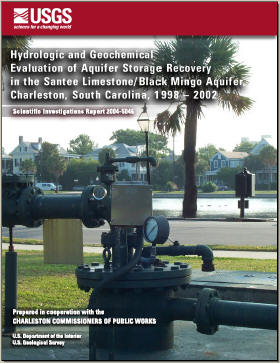Scientific Investigations Report 2004-5046
U.S. Geological Survey Scientific Investigations Report 2004-5046, 92 pages (Published 2004)
ONLINE ONLY
By Matthew D. Petkewich, David L. Parkhurst, Kevin J. Conlon, Bruce G. Campbell, and June E. Mirecki
![]() This report is available online in pdf format (34 MB): USGS SIR 2004-5046
This report is available online in pdf format (34 MB): USGS SIR 2004-5046

The hydrologic and geochemical effects of aquifer storage recovery were evaluated to determine the potential for supplying the city of Charleston, South Carolina, with large quantities of potable water during emergencies, such as earthquakes, hurricanes, or hard freezes. An aquifer storage recovery system, including a production well and three observation wells, was installed at a site located on the Charleston peninsula. The focus of this study was the 23.2-meter thick Tertiary-age carbonate and sand aquifer of the Santee Limestone and the Black Mingo Group, the northernmost equivalent of the Floridan aquifer system.
Four cycles of injection, storage, and recovery were conducted between October 1999 and February 2002. Each cycle consisted of injecting between 6.90 and 7.19 million liters of water for storage periods of 1, 3, or 6 months. The volume of recovered water that did not exceed the U.S. Environmental Protection Agency secondary standard for chloride (250 milligrams per liter) varied from 1.48 to 2.46 million liters, which is equivalent to 21 and 34 percent of the total volume injected for the individual tests. Aquifer storage recovery testing occurred within two productive zones of the brackish Santee Limestone/Black Mingo aquifer. The individual productive zones were determined to be approximately 2 to 4 meters thick, based on borehole geophysical logs, electromagnetic flow-meter testing, and specific-conductance profiles collected within the observation wells. A transmissivity and storage coefficient of 37 meters squared per day and 3 x 10-5, respectively, were determined for the Santee Limestone/Black Mingo aquifer.
Water-quality and sediment samples collected during this investigation documented baseline aquifer and injected water quality, aquifer matrix composition, and changes in injected/aquifer water quality during injection, storage, and recovery. A total of 193 water-quality samples were collected and analyzed for physical properties, major and minor ions, and nutrients. The aquifer and treated surface water were sodiumchloride and calcium/sodium-bicarbonate water types, respectively. Forty-five samples were collected and analyzed for total trihalomethane. Total trihalomethane data collected during aquifer storage recovery cycle 4 indicated that this constituent would not restrict the use of recovered water for drinking-water purposes. Analysis of six sediment samples collected from a cored well located near the aquifer storage recovery site showed that quartz and calcite were the dominant minerals in the Santee Limestone/Black Mingo aquifer. Estimated cation exchange capacity ranged from 12 to 36 milliequivalents per 100 grams in the lower section of the aquifer.
A reactive transport model was developed that included two 2-meter thick layers to describe each of the production zones. The four layers composing the production zones were assigned porosities ranging from 0.1 to 0.3 and hydraulic conductivities ranging from 1 to 8.4 meters per day. Specific storage of the aquifer and confining units was estimated to be 1.5 x 10-5 meter-1. Longitudinal dispersivity of all layers was specified to be 0.5 meter. Leakage through the confining unit was estimated to be minimal and, therefore, not used in the reactive transport modeling.
Inverse geochemical modeling indicates that mixing, cation exchange, and calcite dissolution are the dominant reactions that occur during aquifer storage recovery testing in the Santee Limestone/Black Mingo aquifer. Potable water injected into the Santee Limestone/Black Mingo aquifer evolved chemically by mixing with brackish background water and reaction with calcite and cation exchangers in the sediment. Reactive-transport model simulations indicated that the calcite and exchange reactions could be treated as equilibrium processes.
Simulations with the calibrated reactive transport model indicated that approximately one-fourth of the total volume of water injected into the aquifer can be recovered as potable water, regardless of the length of the injection period. Simulations also indicated that calcite dissolves near the injection well and precipitates where freshwater and brackish water mix during injection. However, the amounts of dissolved and precipitated calcite have a negligible effect on the aquifer porosity for simulated injection periods as long as 100 years and do not affect the flow of water during aquifer storage recovery. Finally, simulations indicated that the regional configuration of the potentiometric surface in the aquifer has a negligible effect on the storage of water.
Abstract
Introduction
Purpose and Scope
Previous Investigation
Description of Study Area
Acknowledgments
Hydrogeologic Framework
Tertiary Stratigraphy
Quaternary Stratigraphy
X-ray Diffraction Analysis
Hydrogeology
Hydrogeologic Methods
Well Construction and Instrumentation
Geophysical Logging
Determination of Aquifer Hydraulic Properties
Aquifer Storage Recovery Testing
Geochemical Methods and Processes
Water-Quality Sampling
Recovery Efficiency
Chemical Composition of Waters
Trihalomethanes
Chemical Reactions During Aquifer Storage Recovery
Reactive-Transport Simulations
Flow-Model Parameters
Transport Simulations
Chemical Reactions
Aquifer Storage Recovery
Recoverable Potable Water
Effects of Injection on Porosity
Effects of a Regional Hydraulic Gradient
Summary
References Cited
Appendix 1. Dissolved inorganic constituent concentrations and water-quality characteristics measured in samples collected during aquifer storage recovery testing in Charleston, South Carolina
Appendix 2. Dissolved trihalomethane and chloride concentrations measured in samples collected during cycle 4 of the aquifer storage recovery study in Charleston, South Carolina
![]() This report is available online in pdf format (34 MB): USGS SIR 2004-5046
This report is available online in pdf format (34 MB): USGS SIR 2004-5046
To view the PDF document, you need the Adobe Acrobat® Reader installed on your computer. (A free copy of the Acrobat® Reader may be downloaded from Adobe Systems Incorporated.)
Petkewich, M.D., Parkhurst, D.L., Conlon, K.J., Campbell, B.G., and Mirecki, J.E., 2004, Hydrologic and geochemical evaluation of aquifer storage recovery in the Santee Limestone/Black Mingo aquifer, Charleston, South Carolina, 1998–2002: U.S. Geological Survey Scientific Investigations Report 2004–5046, accessed May 24, 2004, at https://pubs.water.usgs.gov/sir2004-5046
For more information, contact the South Carolina Publications Unit.
![]() USGS South Carolina Publications • South Carolina Water Science Center
USGS South Carolina Publications • South Carolina Water Science Center